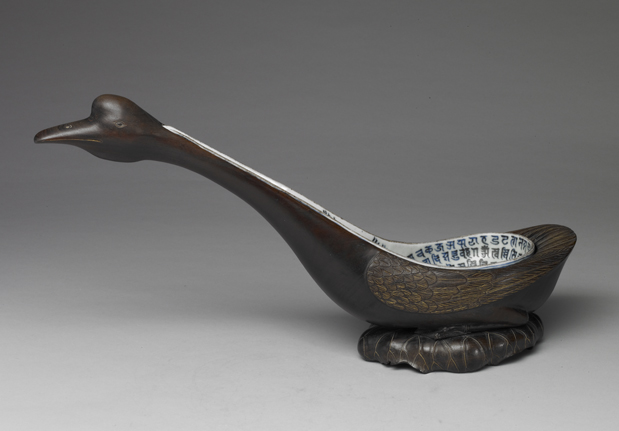Spoon with lotus decoration and Sanskrit letters in underglaze blue, Ming dynasty, Yongle reign (1403-1424)
- Image Number: K1B016761N000000000PAD
- Dynasty: Ming dynasty
- Category: Ceramics
- Function: Eating utensils or sacrificial vessels
- Material: Minerals/Ceramics/
- Description:
The utensil is in the shape of a ladle, with a long handle that is long and thin, wide in the front and narrow in the back. The whole ladle is full of glaze inside and outside, but there is no glaze around the mouth. It is made by re firing. The outer wall is in the shape of a ladle with blue and white flowers, decorated with twenty-four broken branches and lotuses, four at the bottom of the ladle, arranged in a diamond shape, and ten at the periphery; There is one at the top of the dipper handle, and three at the bottom are arranged in a group to form a pinyin shape. There are three groups of nine. Two blue lines are painted along the outer wall mouth as decorations. There is a Sanskrit seed character written on the inner wall of Piaoxin, with five circles around the Sanskrit seed character, from the least to the most. There are three rows of horizontal Sanskrit seed characters on the ladle handle, one line in the middle is longer, and the two sides are shorter. The blue and white glaze is rich and colorful, with iron brown or iron black crystal defects in many places, and the white glaze is bluish. The fetal bone is thin, firm and delicate. The Sanskrit seed word is also called “one word truth”. The word “seed” refers to Sanskrit as the name of all Buddhas. Each Buddha, Bodhisattva, etc. has its own seed word. the Ming dynasty

![图片[2]-Spoon with lotus decoration and Sanskrit letters in underglaze blue, Ming dynasty, Yongle reign (1403-1424)-China Archive](https://chinaarchive.net/Ming dynasty/Ceramics/K1B016761N000000000PAD-54193.jpg)
Pictures & Images [HD] download
© Copyright
The copyright of the article belongs to the author, please keep the original link for reprinting.
THE END





